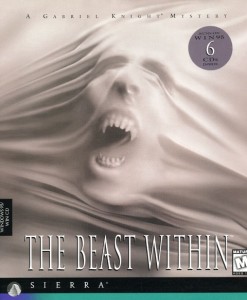376th played so far
 Genre: Adventure
Genre: Adventure
Platform: PC
Year of Release: 1995
Developer: Sierra On-Line
Publisher: Sierra On-Line
For a long time now, my personal page on this blog has listed, as one of the biggest omissions in the list, the Sierra adventure games. As you can see above, this is a Sierra On-Line game. I still stand by my decision though.
While the Gabriel Knight series certainly derives from their tradition and builds on their experience, it diverges in some key ways – there’s no real death scenarios or ways to get stuck, and it’s more serious than the otherwise often whimsical scenarios. For that reason it’s not generally seen as ‘classic’ Sierra.
Our Thoughts
As we jump into the game, it’s clear it’s more linked to another trend popular in the mid-nineties (and really at no other point in history) – the FMV scenarios. With the advent of CD-ROM, it became easier to include vidoes in games, and for a short while a large number of adventures using real actors appeared. As 3D rendering became easier and cheaper, the inflexibility of using real actors became more noticeable and the genre quietly disappeared a few years later, only to be remembered by a single Gabriel Knight installment, as well as early notable example Phantasmagoria, the Tex Murphy series and the originally hyped 7th Guest. These days it’s constrained to a handful of cutscenes in some games – Command & Conquer is still famous for it, as was the Myst series for some time – but if you want real acting in, motion capture is now the way to go.
Playing this game shows why. Aside from the inability of getting any graphical update for this, the quality of the video and static photos used for the background (most of the actors interacting with the world appears to be greenscreen) aren’t that great due to capacity constraints. It feels incredibly awkward anyway, with long stretches of Gabriel just standing there while you go through what to do. Somehow all of this is feels less awkward when it’s an animated character doing it than when it’s a filmed actor, possibly because you expect it from animated characters, animation misses out the nuances. FMV games are tied to similar time constraints, but have to fit in the more natural movements you expect from real people.
What doesn’t help is that, due to the commitments of filming (which is a lot more intense than voice-acting’s “come in for an afternoon to read these lines”) the actors used are not well known ones (something that comes down to cost), which shows in their acting. Gabriel Knight, our main hero, seems the best example of this. While in the first game, he was voiced by Tim Curry (using a slightly dubious accent, but mostly pretty good), the replacement actor (whose only other IMDB credit is as an extra in a few episodes of Frasier) feels off. The word ‘wet blanket’ comes to mind. I suppose it’s not entirely unconvincing, but you still get the feeling you’re watching an amateur production. Add to that a few silly special effects of sorts and the longer time it takes to play all the feedback, and the game feels ripe for mocking.
While the acting is mixed, the environments work a bit better. They’re photos combined together – with a similar issue of lower quality – taken of the real life locations the story takes place in. With a bit of painting, but we can’t have everything. It’s probably the main thing that adds realism to the story – something the actors don’t pull off – and that makes the proceedings more interesting. While there are fantastical elements to the game and story, most of it really is about real life. And yes, it actually looks like you’d want to visit those places some day, if only because of all the history involved in it.
The story, then, comes together a lot better when you get to it, and this is where the game shines. Between the acting, you get the sense of a larger mystery involving werewolves (not a big spoiler there), with giant wolves that aren’t, and some stories of a mad German king from a few centuries ago. It mixes real life myths with the game’s fiction in a pretty interesting way.
The puzzles, meanwhile, are mostly straightforward. There’s the usual downside of occasional tricky hotspot finding, as well as a few odd item combinations (and one puzzle that was weirdly timebased in a way that wasn’t really signposted, where I couldn’t initially get it because I was too quick in showing someone an item), but mostly they’re sensible. There’s a weird minigame puzzle that comes down to tape splicing where the game is stupidly precise about wording – because it can’t do more, but some more flexibility would have been welcome. The live acting probably restricted solutions more than other games would have, but in general the game is sane and fairly straightforward in this sense.
Final Thoughts
We have come a long way in gaming technology, something demonstrated by this game requiring 6 discs in order to run and yet we have games like Red Dead Redemption running on one disc and bitch about having to change them for Mass Effect 2. As interesting as the story is I can not get past the actor portraying Gabriel Knight and wondering whether the live-action FMVs actually hindered this game rather than helped it.